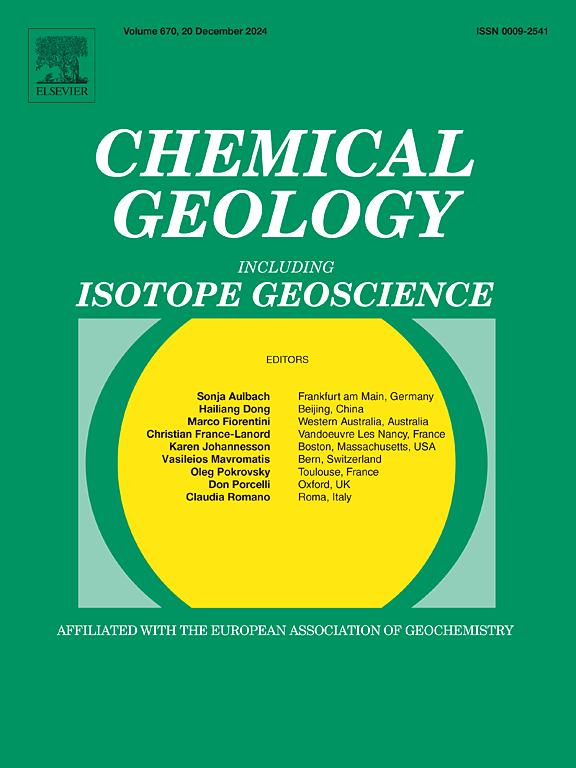Zinc mineralisation in marine ooidal ironstones of Western Siberia: Origin and palaeoenvironmental significance
IF 3.6
2区 地球科学
Q1 GEOCHEMISTRY & GEOPHYSICS
引用次数: 0
Abstract
The intricate nature and evolution of the zinc (Zn) biogeochemical cycle in modern and ancient sedimentary basins is a captivating scientific issue with regard to the complexity of Zn sources, diffusion paths and immobilisation processes. This article delves into assessing the sources, migration pathways, and concentration mechanisms of Zn in marine ooidal ironstone deposits of Western Siberia. The study focused on the Cretaceous-Paleogene ironstone strata of the ∼80 m thick Bakchar deposit. The study is based on SEM-EDS, XRF, ICP-MS, and Rock-Eval pyrolysis analyses. In this deposit, Zn minerals frequently form inclusions in the carbonate cement and clay matrix, including micro-impregnations at the contact between siderite spar and the clay matrix, or less common in the cortex of iron-rich ooids. Authigenic Zn mineralisation is predominantly represented by wurtzite ((Zn, Fe)S), while Zn nuggets, zincite (ZnO), tongxinite (Cu2Zn) and Zn-bearing sulphides occur less frequently. They are observed across all major ironstone-bearing Formations of the Bakchar deposit, which span from the Turonian-Coniacian to the Paleocene-Eocene. The inclusions in some layers form clusters that are more commonly associated with carbonate (siderite) cements. This is explained by intense seepage of hydrothermally sourced (reducing and acidic) fluids, likely linked to fault-controlled fluid migration within the bored rift zones of the West Siberian basin. Migration of Zn-bearing low-temperature hydrothermal fluids occurred into weakly lithified or well lithified marine sediments after the formation of iron-rich ooids and primary clay matrix, as reflected in the composition of wurtzite framboids and fracture forms with carbonate-filled ooids and quartz (epigenetic mineralisation). This epigenetic zinc mineralisation may have overprinted the earlier diagenetic phases, reflecting the complex multi-stage history of the deposit. At moderate or prolonged fluid diffusion rates (distal to the exhalation centre), wurtzite crystallised in a smectite matrix near siderite aggregates or immediately at the smectite-siderite grain boundary. Under such conditions, wurtzite often replaced pyrite framboids. During intense fluid-rock interactions, wurtzite and other Zn sulphides crystallised in siderite micro-veins, which altogether replaced and overprinted previously formed ooids and detrital quartz. A more enigmatic form of wurtzite is an ‘almond-shaped’ variety that grew within the pores of detrital organic matter. In rare cases, native Zn and tongxinite formed in micro-pores between clay microparticles. Within the deposits, Zn is positively correlated with hydrothermal and anoxic metals, such as Co, Pb, REE, Y, U, Sb, Mo, As, Th, Fe and Ni, but negatively or barely correlated with K, Si, Ba, Ge, Al and TOC. This distinct geochemical association suggests a hydrothermal origin of the Zn mineralisations. Based on the mineralogical and geochemical results obtained, we propose new diagnostic criteria (e.g., Zn/Fe ratio and distinct Zn mineral assemblages in carbonate cement) for the search of proximal zones of seep processes within ooidal ironstone deposits, which provide valuable insights into Zn mineralisation processes.

求助全文
约1分钟内获得全文
求助全文
来源期刊

Chemical Geology
地学-地球化学与地球物理
CiteScore
7.20
自引率
10.30%
发文量
374
审稿时长
3.6 months
期刊介绍:
Chemical Geology is an international journal that publishes original research papers on isotopic and elemental geochemistry, geochronology and cosmochemistry.
The Journal focuses on chemical processes in igneous, metamorphic, and sedimentary petrology, low- and high-temperature aqueous solutions, biogeochemistry, the environment and cosmochemistry.
Papers that are field, experimentally, or computationally based are appropriate if they are of broad international interest. The Journal generally does not publish papers that are primarily of regional or local interest, or which are primarily focused on remediation and applied geochemistry.
The Journal also welcomes innovative papers dealing with significant analytical advances that are of wide interest in the community and extend significantly beyond the scope of what would be included in the methods section of a standard research paper.
 求助内容:
求助内容: 应助结果提醒方式:
应助结果提醒方式:


